How do you find such an animal?
By James B. Spencer
If you're a "golden person," no other breed will quite do. If you're not, even the finest golden may not please you. How can you tell which you are? Read the following description of the ideal golden and trust your instinctive reaction.
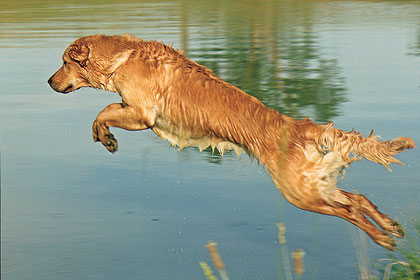 The ideal golden hits the water with great enthusiasm. |
Incidentally, although I've been involved directly with the breed since 1968 and indirectly since 1948, for this article, I've interviewed three other long-time goldenites: Lorie Jolley, Dana Oaks, and Chuck Wheeler. See the "Interviewees" sidebar for information about them.
The "Ideal" Golden
Physical
The breed standard says males should stand 23 to 24 inches at the withers and weigh 65 to 75 pounds, while females should stand 21.5 to 22.5 inches and weigh 55 to 65 pounds. Such an animal is substantial without being ponderous. Properly assembled, he exhibits athleticism in every movement.
"Overall structural balance," Dana Oaks said, "makes a golden athletic. Good front. Good rear. Proper, but not extreme, angulation fore and aft. Balance."
The double coat has a dense, insulating undercoat overlaid by a longer outercoat for protection from the often punishing hunting environment. The outercoat shouldn't be excessively long and should be relatively waterproof. The color might be any shade of gold, from light yellow to deep orange.
"In duck hunting," Chuck Wheeler said, "my golden sometimes gets covered with ice, but I can warm my hands up by pushing them down into his undercoat!"
"The outercoat," Lorie Jolly said, "should dry quickly after a good shake."
Clearly, the ideal golden's appearance and movement should suggest the work for which the breed was developed.
Temperament
The ideal golden's charming personality so matches his physical beauty that what you see is truly what you get. He's gentle, affectionate, outgoing, eager to please, and friendly with man and beast.
If he has a temperament fault, it's that he's a total washout as a watch dog. He loves everyone too much to be protective or territorial. If a burglar could let the resident golden know what he wants, said golden would lead him straight to it, and might even carry it out to his car!
Keenly aware of the boss' wishes, the golden adapts his energy level to his immediate situation. When working in the field, he's pleasingly stylish, while around home he's comfortably laid back.
This rare combination of beauty and charm explains why the breed has "enjoyed" such great popularity for the past several decades.
Working Ability
The ideal golden's genes must carry five working traits: birdiness, retrieving instinct, marking ability, a good nose, and trainability.
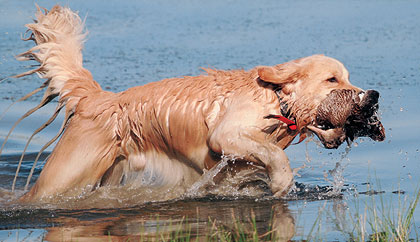 The ideal golden brings ducks back rapidly and tenderly. |
First, he must be extremely birdy. Otherwise, he'd be too smart to go into the places he must enter and do the things he must do to help the boss enjoy an occasional feast on birds he's by-George shot himself!
Second, he needs a strong natural instinct to retrieve. Actually, this is more an instinct to carry objects to his lair, which training converts into retrieving. If you watch a litter of well-bred goldens at play, you'll see that most of them just love to carry small objects around. Some older goldens are seldom without something in their mouths, whether an old shoe, a food bowl, or whatever. This trait is in their genes, Deo gratias!
Third, he needs reasonable marking ability, so he can locate the birds shot over him. Granted, few goldens equal the average Chesapeake or the better Labs in marking.
Nevertheless, the ideal "rug" (as goldens are sometimes called by Lab and Chessy folks) won't often need help finding a bird he has seen fall, although he may hunt a larger area.
Fourth, he needs a good nose. Actually, most goldens excel Labs and Chessies in this trait, but they need to in order to overcome their somewhat lesser marking ability.
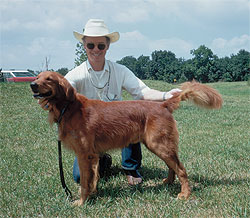 Jim Spencer's "Duffy" (Duncan Dell's MacDuff **CD, VC). Although not an All-American, Duffy's Versatility Certificate (VC) shows he was a three-sport letterman (field, obedience, and conformation). This picture was taken back when both Duffy and Jim were in their primes. |
Fifth, he needs trainability, and here the golden surpasses every other sporting breed. In the very demanding blind retrieve training, the ideal golden is an absolute joy. His strong desire to please combined with his attentive mind and excellent memory give him an edge here that he lacks in marking. An old saying claims that goldens love to be trained, Chesapeakes resent it, and Labs don't care much one way or the other.
One training caveat: The golden has a strong desire to please and learns best from a trainer who freely expresses his pleasure while training (and hunting). Not being stubborn or hard-headed, the golden responds best to training that is mostly positive. He needs few corrections and will not work well for the heavy-handed trainer.
"The golden," Lorie Jolly said, "will take fair corrections but is more receptive to positive reinforcement."
The ideal golden is properly endowed with these five inherited traits. Thus, with proper training, he can become an outstanding hunting dog in both marshes and meadows. He can retrieve waterfowl in the foulest (pardon the pun) weather from bone-chilling water without apparently suffering any more discomfort than his bundled-up boss.
"I hunt mostly on the San Juan River," Chuck Wheeler said, "with slush ice floating downstream. My goldens don't seem to notice the cold. I guess they just want that bird desperately!"
"In jump-shooting" said very feminine Lorie Jolly, a self-described high-maintenance tomboy, "my golden creeps along very
quietly beside me through 'whatever.'"
 Dana Oaks and two of his goldens. Photo by Dana Oaks. |
"Hereabouts we hunt waterfowl mostly from blinds," Dana Oaks said, "sometimes with multiple hunters and multiple dogs. My goldens are always perfect gentlemen in such situations."
The ideal golden can also quarter in the uplands to find, flush, and retrieve birds. Granted, the boss may have to stop from time to time to remove burrs from his dog's lovely coat, but that's a small chore for a golden person.
"When pheasant hunting," Lorie Jolly said, "my golden quarters within 30 yards, and when he gets birdy, I prepare for a flush."
"We hunt upland birds near railroad tracks and fence lines," Dana Oaks said, "where control is an absolute must. My goldens give it to me, very willingly."
"I sometimes use a setter," Chuck Wheeler said, "and keep my golden at heel for retrieving. No problem. He enjoys the camaraderie, and the show!"
So much for the ideal golden. Now let's look at the current realities that make finding one such a challenge.
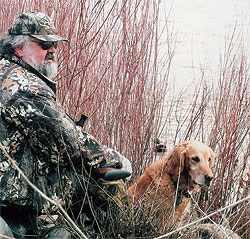 Chuck Wheeler. Photo by Chuck Wheeler. |
Today's Problems
Over-Popularity
Prior to October 3, 1974, the golden was a relatively rare breed. Before then, I was once asked if my old Duffy (Duncan Dell's MacDuff ** CD, VC) was an Irish setter! Then, on that fateful 1974 day, President Ford brought a golden, Liberty, into the White House, and America discovered the breed--big time.
TV ads with goldens followed ad nauseam, until owning a golden became a national "in thing," and the golden has been among the most popular breeds ever since. Frankly, as a dedicated goldenite, I've always wished that Nixon rather than Ford had brought Liberty into the White House.
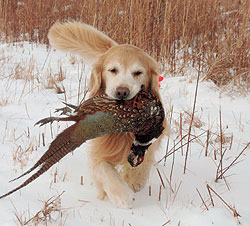 The ideal golden is a great upland hunter and retriever€¦in all kinds of weather. Photo by Dana Oaks. |
So what's wrong with popularity? For starters, it encourages "casual" breeding by people interested in money rather than the breed. To be kind, I'll call the dogs from such breedings "pet stock," but that euphemism doesn't improve their quality.
What serious breeders call the "drag of the race," that is, the tendency of successive generations of casually bred dogs to deteriorate in quality, has seriously damaged today's huge population of pet-stock goldens. Thus, many of them resemble the breed standard only faintly.
Many have little or no working ability. Many suffer debilitating and even life-threatening hereditary health problems. And worst of all, at least some of them exhibit an atypical aggressiveness toward other dogs and even toward people.
In short, they are goldens in name only. Worse still, such "goldens" are bred and bred and bred. Why? Because the puppies sell well.
Consequently, some experts estimate that 85 to 90 percent of this country's current golden population is of this inferior pet-stock type. Clearly, to get an ideal golden, you must be very careful, very selective, and above all, very knowledgeable.
Breed Split
Even before the breed became so popular, it was beginning to split into two types, one for conformation shows, the other for field trials. Since both of these dog games are highly competitive, each encourages a different kind of specialization. The Golden Retriever Club of America (GRCA) now sponsors two non-competitive events, one for conformation testing, the other for field testing.
The former awards a Certificate of Conformation Assessment (CCA) to goldens with acceptable conformation. The latter awards a Working Certificate (WC) or Working Certificate Excellent (WCX) to goldens that perform adequately in GRCA field tests. The intent of these two programs is to mend this breed split. Being non-competitive, given enough time, they could do that. Check the GRCA Website (see GRCA Sidebar) for more information on these programs.
The huge population of pet-stock goldens constitutes another split, one that offers no real hope of correction as long as the breed remains so popular and pet-stock puppies sell so well.
More recently, a fourth split has been started, this one by agility and obedience competitors intent on breeding smaller, quicker goldens that can compete with border collies. (Why, you ask, don't they just buy border collies? Beats me!) If this split continues, it won't lend itself to an easy solution.
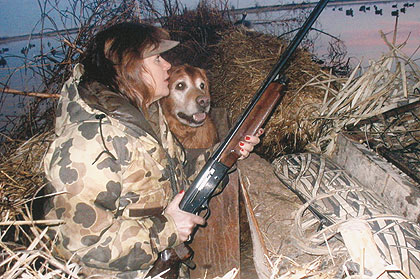 Lorie Jolly, the self-described "high-maintenance tomboy." (Notice the nail polish and coif.) Photo from Lorie Jolly. |
As you can see, to find your ideal golden, you have to learn a lot about the various kinds of breeders.
Hereditary Health Problems
Finally, goldens suffer the usual hereditary health problems that affect almost every breed today: hip and elbow dysplasia, heart disease, eye disease, and cancer. See the GRCA Website (GRCA sidebar) for more information. Serious breeders breed only sound animals. But serious breeders are in the minority today, so caveat emptor.
Finding An Ideal Golden
If you're a golden person, you won't mind doing all the research it takes to find an ideal pup for yourself. In fact, you'll enjoy it. Check the GRCA website (see GRCA Sidebar) for bountiful information on the breed, its various problems today, and how to find responsible breeders. Then check out a few.
See their breeding stock in action. Examine their dogs' health clearance certificates. Get references and contact them. Then opt for the breeder who measures up and with whom you have a comfortable rapport. Select a litter that fits your goals, even if you have to wait several months for the breeding.
Which puppy? Play with them all, and then go with your heart. Choose the one that somehow gets to you.
Since this will probably be your first golden, let me close by wishing that he pleases you as much as my first one, Duffy, has pleased me, first for over 16 years in life, and now for over 24 years in memory.






